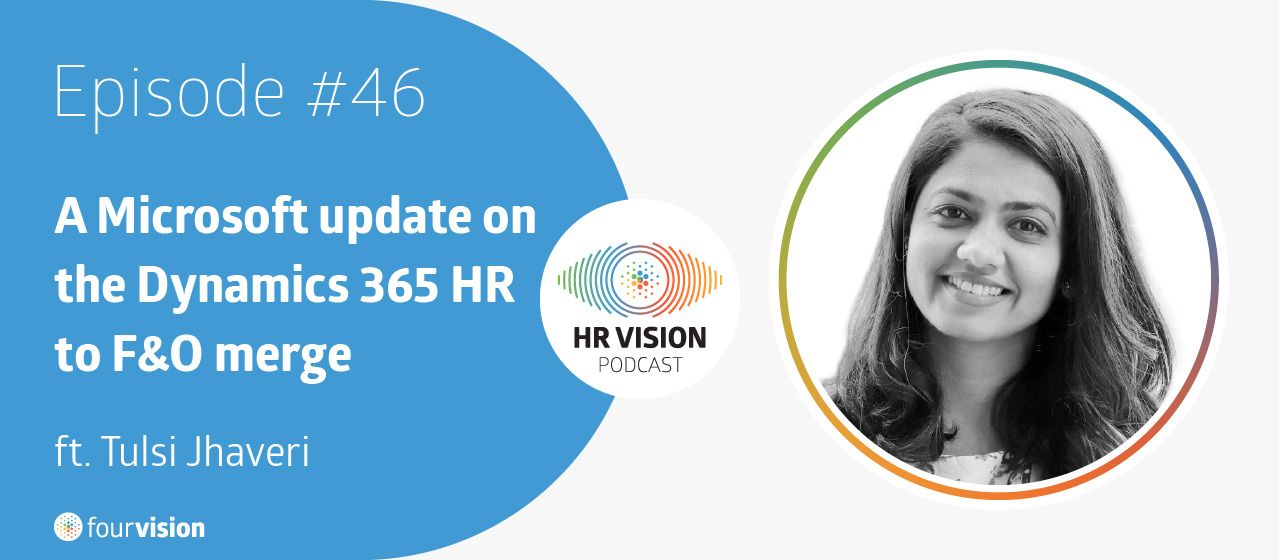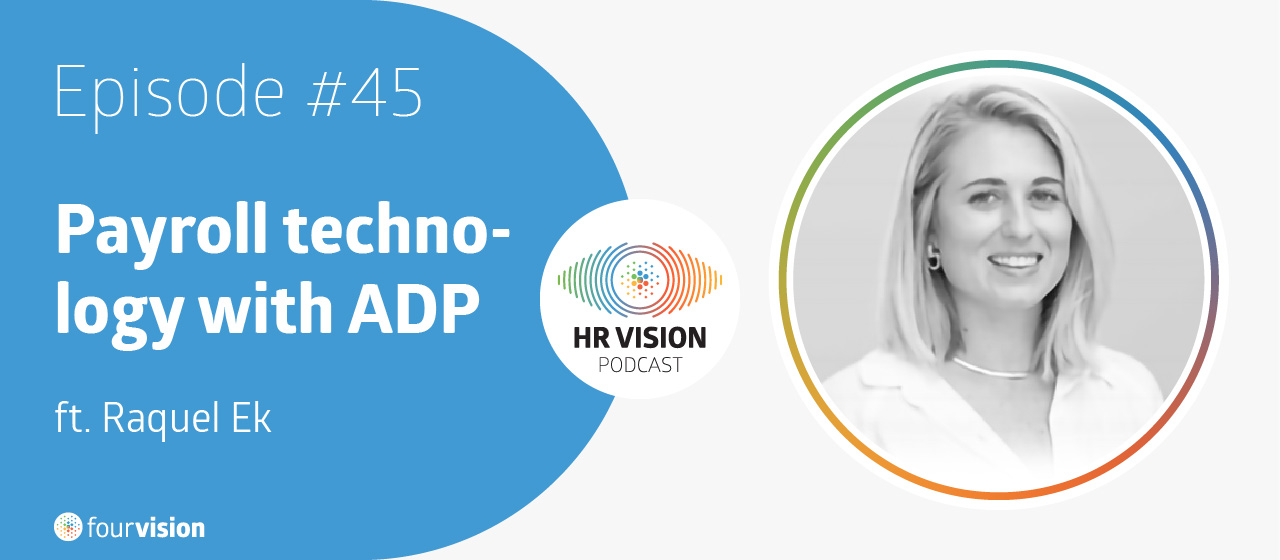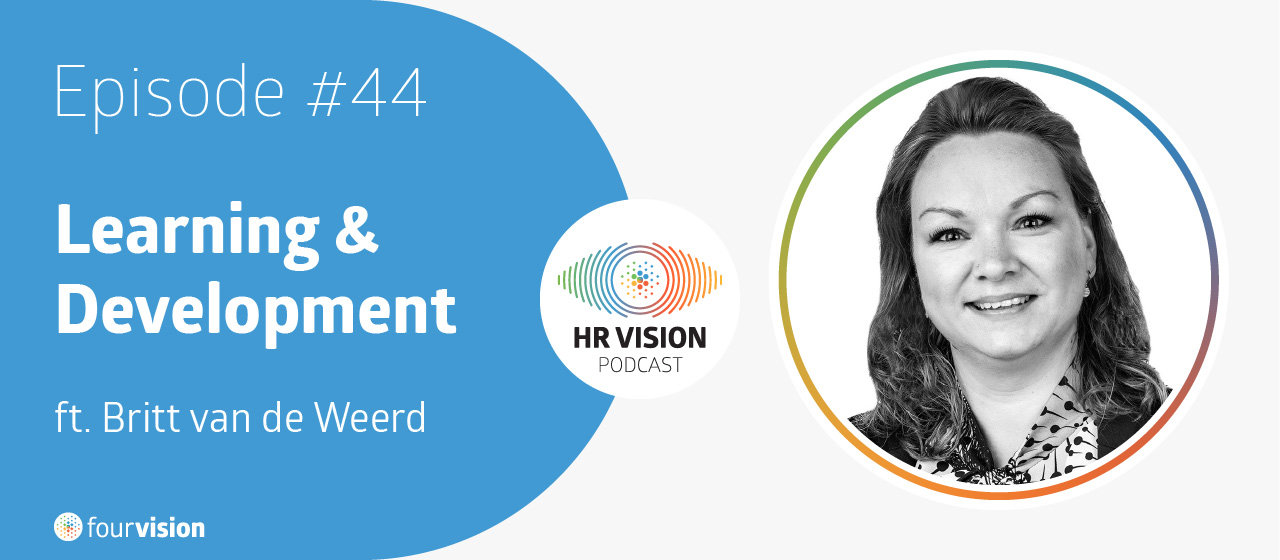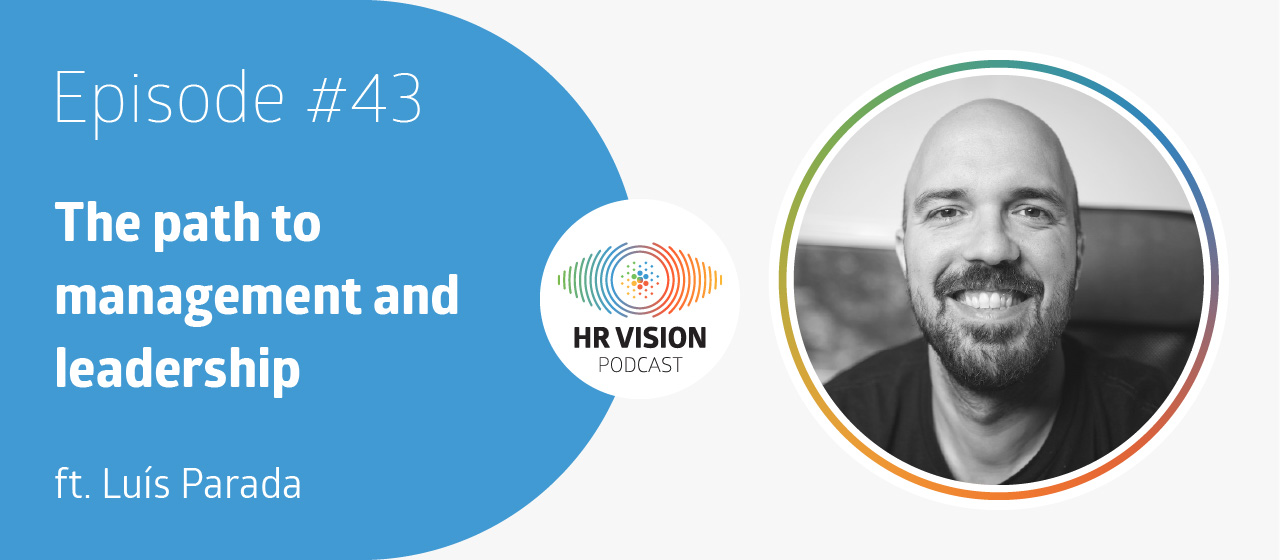If you haven’t heard it yet, Microsoft is merging its Dynamics 365 HR module into Dynamics 365 Finance & Operations. This means that Dynamics 365 HR ends as a standalone SaaS application and all the functionalities within the former HR platform move into the bigger environment of Finance & Operations.
Microsoft has been working hard to make this merge happen, so we figured it was time to get an update from the source!
Tulsi has a solid track record with Microsoft Business Applications. First as a Consultant and now on the other side, as a Product Manager at Microsoft.
She came on the podcast to give us an update on this major project she’s spearheading, its most recent developments, updates about licensing, timelines and more.
We hope you find it insightful!
Ivo:
Hey there. Welcome to Episode 46 of the HR Vision podcast. I hope everyone listening is doing well. On today's episode we will be talking Microsoft and some recent news that are important to the HR community. So it's only fitting to have a Microsoft person with us, right? So let me welcome Tulsi to the podcast. Hey Tulsi, how's it going?
Tulsi:
Good. How are you?
Ivo:
I'm doing great. Thank you so much for coming on. Tulsi has a solid track record with Microsoft Business applications. First as a consultant, she even was a part of the FourVision team once. Long, long time ago, maybe not. Now on the other side as a product manager at Microsoft. So she will talk a bit more about that in a moment. But today, me and Tulsi will mainly talk about a very specific subject. The ongoing merge, announced last year about taking the Microsoft Dynamics 365 HR module back to the Finance and Operations platform. There is not a lot of content about it, but Microsoft gave us a bit more clarity recently and that's why Tulsi kindly accepted our invitation to be here with us. So let's not waste any more time. Tulsi let's start with you, give us a bit of an intro about yourself and your professional background.
Tulsi:
Thanks, Ivo. Thank you for having me. It's always a pleasure coming back, you know, and having the conversations with old colleagues, of course. So I, like you mentioned, I am currently a product manager with Microsoft. I am spearheading one of the biggest impactful topic of infrastructure merge. And I have been with Microsoft for about a year, now, and I have been in the Dynamics world for almost a decade.
Ivo:
Wow.
Tulsi:
So yeah, just working with various partners and ISP's and mainly focusing on the Human Resources product. But I also have a little bit of background in finance and project operations, etc.
Ivo:
OK. So that's why it makes a lot of sense that you're here today. So let me ask you, what has been your experience so far on the other side, right, with Microsoft and what have you been up to lately?
Tulsi:
Well, it's been all about the whole infrastructure merge. So we have been bringing the Human Resources product that was a standalone platform, back into Finance and Operations platform. So that has been my main focus over the last year.
Ivo:
All right, all right. So let's talk about that. I guess, the people listening and people following us for some time, they kind of know what this merge is about and why it is happening. But let's recap a bit on that since you're here, let's start there. What is this merge all about and why is it happening?
Tulsi:
Yeah. So HR, Human Resources was a module part of the Finance platform and at some point, about four or five years ago, it was taken onto its own standalone application that was providing the flexibility for customers. And now we're just bringing it back because, from the platform perspective, it gives a lot of additional capabilities to the customers. So we're just taking that standalone, bringing it back into Finance and that way the customers that have a Finance and Project Operations and other applications would be able to utilize it in a more cohesive manner.
Ivo:
OK. Besides that cohesiveness. Can you talk a bit more about what are the other benefits of bringing you know that these HR platform into the Finance and Operations?
Tulsi:
Yeah, absolutely. So it provides a great flexibility in terms of extensibility, provides flexibility of the platform that we have on the Finance infrastructure that we did not have. So the standalone Human Resources has been a sealed solution. So there was no code level development from customers and partners perspective that could be done. It was all, you know, whatever standard application provided and then you had other means to extend it from personalizations and save views and things like that. But there was no real code development or code extensibility that was available on the standalone application. Whereas when we have this on the Finance infrastructure, there is that available for partners and for customers. So if there are specific scenarios that are applicable where they need to extend that solution from you know customization perspective, that is available. Integration is also more flexible right? So you can use different extensibility platforms to integrate with other areas, other applications, third party solutions, etc. In a more improved manner than what used to be available.
Ivo:
Do you think it will become a very much more solid, probably? All around, right.
Tulsi:
Absolutely.
Ivo:
All right. We've been talking or we've been hearing as well these two terms, migration and merge. So I would like, I would like to ask you to try to clarify a little bit, it seems like migration is the first step and merge will be the ultimate step in this whole process. But can you clarify a little bit about that?
Tulsi:
Absolutely. So that's actually a really great question cuz I know there has been a little bit of confusion in the community around it. So I'm glad you asked. So the infrastructure merge itself is what we did as product group, Microsoft did, to bring in the solution from the standalone application onto the Finance platform. The customer migration is what we're referring to as lift and shift migration. So this is where we provide that automated tooling that allows you to use LCS. This is through LCS, lifecycle services, that allows you to migrate your standalone application onto Finance. All your database, all your workflows and your personalizations and security roles. All of that gets automatically brought into the Finance in an empty environment.
Ivo:
Yeah.
Tulsi:
So that is your customer migration. Merge itself is an optional step. The customer merge it is not required. This is more for customers that have Finance or Project Operations and other applications that they're using. If they want to bring all of that with HR into one environment, that is where the merge happens. If that is something that the organization desires. So we are not requiring for customers to merge if they wish to keep the environment separate for Human Resources and other applications. That is absolutely at their discretion.
Ivo:
Pretty clear to me alright. Microsoft, and you just mentioned it there, Microsoft announced recently its automated migration tooling for this operation, right? It's being called the lift and shift thing. So yeah, what can you tell us about that? What is that? What is that tooling and how it will help partners, clients to move their environments from HR to Finance and Operations.
Tulsi:
Yeah. So like I mentioned earlier, you can use lifecycle services to migrate your environment in more automated manner. This is based on the licensing that the customer has. So if you have Human Resources licenses you automatically get access to this project, that you can create on lifecycle services or LCS. And once you create that project you have the migrate HR button available, that you don't have if you don't have the appropriate licensing or if you're not a Human Resources customer, right? Because this is specific to recurrent customers that need to migrate. And what happens is you can create a copy of your production environment into sandbox and then migrate your sandbox. Which is your test environment, default acceptance testing environment. So you can migrate your sandbox, do your validation and again that would migrate everything for you. And you can do your validation testing. You can do as many iterations as you would like to migrate your sandbox. Just to get comfortable with the process. Then once you're comfortable with that, have your appropriate onboarding done, your methodology done. Because it's similar to the current Finance customer experience as well. You have to just go through all of those onboarding processes methodology and do your subscription estimator, etc. Then once you go through all of those processes and verify that you have migrated your sandbox, etc. You get access to your production environment on Finance and you can migrate your production in the same manner. The whole automated process takes approximately 3 to 4 hours depending on customers data. So that's the estimated downtime, but it could be less.
Ivo:
OK. It doesn't seem a lot to me. That's pretty good work by Microsoft. Before going to scenarios and what this can mean to customers and what maybe they will do in each scenario. I have a question, kind of a curious question, because we have a lot of good feedback about the integration of Leave and Absence bot on Teams. People being able to book their leave through Teams and that is very much based on the Dynamics 365 HR platform, right? So being based on it, will it still be available after the migration? After the merge will be something that Microsoft will take care of?
Tulsi:
Yes so, it is currently. So we're in the process of migrating that Teams integration solution to a Power Platform based solution. So it's called Power pages. It's a new technology that the Power Platform is spearheading. So we are in the process of migrating that integration solution. And once it is available, it will be available on the Finance infrastructure. So currently it is still only available on the standalone application, but you know once we have released that new technology based solution, it will be available.
Ivo:
All right. That's pretty clear. Now let me give you 3 scenarios of clients or customers and you let me know what is going to happen with them in terms of this migration or merge. So if a customer, all he has Dynamics 365 HR, doesn't have Finance and Operations. They will need to be migrated right to the new tool. What are the steps they need to take, they or their preferred partner, to do this merger migration for them?
Tulsi:
Absolutely. So like I mentioned before, since they are current Human Resources customer, they will get access to a new LCS project. So they'll be able to create that project and have those migrate tooling available within LCS and they will be able to follow the steps to just migrate their sandbox initially go through the methodology and onboarding process to ensure appropriate steps have been taken, etc. Then they'll have access to their production environment and they would be able to migrate their production environment. All of this is an automated process outside of the validation, which is similar to any implementation that they would do.
Ivo:
OK, I'll follow up on this scenario. I don't know if you can answer this, but in any case I will ask. What happens to licensing there, right? You have a license to use an Dynamics 365 HR, will that be transferred into Finance and Operations, that license?
Tulsi:
Absolutely, absolutely. So again, a great question Ivo. So the licensing currently is different for Finance customers and for Human Resources customers, right? For Finance customers there is a requirement of minimum 20 full seat. Whereas on the Human Resources side we have full five seat licenses and requirements. So that still stays the same. So whatever licenses the customer has currently will be transitioned to the Finance side. So they will have access to the new environment based on their current licensing.
Ivo:
Perfectly clear like spring water. Alright, let's go over another scenario. So if a customer or client only has Finance and Operations right now. They want to include an HR module in there. Is this migration necessary at all for them or will just the HR module be ready for them to acquire within the Finance and Operations platform? What happens there?
Tulsi:
So. The functionality, Human Resources functionality is available but their data that is in their HR application, the standalone application needs to be migrated. So similar to the standalone customers, they can use that migration project to migrate their standalone application environments to Finance environment. Which will be a separate environment. If they decide to merge on their existing environment. A lot of that is manual process. We are working to provide additional resources but a lot of that will be manual. So some of the resources that we are working on to provide is additional templates and things like that. But a lot of that is more so data management framework templates that uses export, import functionality that is currently available. So we have identified certain gaps from entities perspective. So we are looking to provide those entities that are not available. But again you know it depends on the data that the customer has. Migration is more of that automated process. The merge itself, if they choose to bring in to their existing Finance environment, will be more of a manual process OK?
Ivo:
Would you advise to contact their preferred partners to do this? Partners probably will be better instructed and better equipped to deal with that, without messing up the data and keeping it secure.
Tulsi:
Absolutely. You know we work with the partner channel for that reason. The partners have the experience with different scenarios and they have the knowledge base from the technical perspective. Because they have additional exposure to the framework behind the solution, etc. So it is helpful, but you know that's a absolutely at the customer's discretion.
Ivo:
All right, let's look into the future. Can you give us an overview of the timelines of what happens next for Microsoft and for all the steps about the migration.
Tulsi:
So the customers that are on the standalone application will need to move from their current standalone Human Tesources to the Finance infrastructure. We just released a public preview of the migration tooling on October 31st. We are working towards getting feedback from customers. The wrinkles and what we've done right. For example, some of the dual right mapping issues, etc. We are also in the process of solidifying the migration tooling to make it generally available. And the idea is to make this available from 12 months of when the tooling is available. So around this time in 2023. That's when the deadline would be for the customers to migrate off of the standalone application.
Ivo:
OK. Do you think that it can depend on the feedback that you get from customers of how difficult this might be. Of course you are not expecting a lot of difficulties with the new automated migration toolbox. But do you think it can be extended in case that customers are finding some difficulties with this migration?
Tulsi:
There are no plans currently to extend the timeline, but we will be sure to work with customers. Of course we recommend, highly, to work with their partners and or fast track team as well. If they are fast track customer. And then we of course have additional guidance available. We have support teams available, to help resolve any issues. But this is one of the reasons that we would recommend moving sooner rather than later. Just so we can identify any blockers and of course work towards giving resolution to any problems.
Ivo:
Makes sense. One one more thing before I let you go about the feedback from customers. Is there something that you can share with us on how customers are taking this? Do they see the value? What is the general feedback that you guys been having?
Tulsi:
Well, the general feedback has been pretty positive from what we have heard. Because the customers, especially the customers that are using multiple applications, they see the value in bringing this onto one platform. The additional flexibility that is available for the solution. We are not deprecating anything, right. All of the functionality is actually just being replaced with better technology. So that has been generally positive. It's a short term pain for long term gain.
Ivo:
Well, that seems like the perfect sentence to end this episode. So, very good Tulsi. This was very insightful. I think it will help a lot of people out there in the in the Community and a lot of customers and the partners as well. So thank you for that. It was very insightful for me. I hope you enjoyed it as well.
Tulsi:
Absolutely. It's been a pleasure as always and if there are any questions or comments, please. I encourage everybody to reach out. We have Yammer groups that are also great resources for collaboration with customers and partners and Microsoft Teams. So highly recommend reaching out as well.
Ivo:
Absolutely. OK, Tulsi, thank you so much once again. Have a good evening. Well, have a good day. In your case, it's evening from my side. So thank you once again and yeah, everyone listening out there. We'll catch you next time.
Tulsi:
Yeah. Thank you.
Sign up to receive email updates
Enter your name and email address below and I'll send you periodic updates about the podcast.







